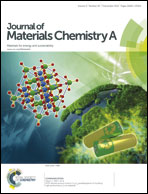Use of a protic salt for the formation of liquid-crystalline proton-conductive complexes with mesomorphic diols†
Abstract
We herein report that molecular assembly of wedge-shaped mesomorphic diols and a protic salt results in the formation of anhydrous one-dimensional (1D) and 2D proton-conductive materials. The protic salt has been obtained by stoichiometric neutralization of imidazole with benzenesulfonic acid. The protic salt is incorporated into the hydrogen-bonded networks of the hydroxyl groups of the mesomorphic diols. This confined protic salt in the nanochannels exhibits enhanced ionic conductivities by three-orders of magnitude compared with those of the pure protic salt in the solid state, indicating that the imidazolium salt forms a mobile state in the liquid-crystalline nanostructures. These self-assembled and ordered materials based on protic salts may be promising candidates for the application as anhydrous proton-conducting electrolytes in fuel cells.


 Please wait while we load your content...
Please wait while we load your content...